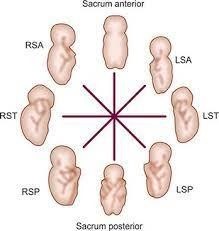A nurse is caring for a client who is 1 day postpartum. The client tells the nurse, "The baby has been breathing funny, fast and slow, off and on." Which of the following responses should the nurse make?
"There's absolutely nothing for you to worry about. Newborns often breathe like this."
"I'll sit here while you feed him and we'll check out his breathing."
"You are going to be a very good, responsible mother to this baby."
"All new mothers feel a bit anxious about things like this."
The Correct Answer is B
Choice A rationale: While it's true that newborns can have irregular breathing patterns, this response may come across as dismissive and not addressing the client's concerns.
Choice B rationale: The nurse should respond by actively listening to the client's concerns and offering to assess the newborn's breathing while they are feeding. Newborns can have irregular breathing patterns, including periods of rapid breathing (tachypnea) and pauses in breathing (periodic breathing). These patterns are generally normal and related to the baby's immature respiratory system adjusting to life outside the womb.
Choice C rationale: This response does not address the client's concern about the baby's breathing and instead focuses on the client's potential as a mother.
Choice D rationale: This response may minimize the client's concerns and does not address the baby's breathing issue. It's essential to acknowledge and assess the newborn's breathing pattern to ensure it is within the normal range.
Nursing Test Bank
Naxlex Comprehensive Predictor Exams
Related Questions
Correct Answer is A
Explanation
Choice A rationale: This statement indicates that the client understands the teaching about managing hyperemesis gravidarum. Eating crackers before getting out of bed in the morning is a common strategy to help alleviate morning sickness and hyperemesis gravidarum. Eating small, bland, and easily digestible foods before rising from bed can help prevent nausea and vomiting.
Choice B rationale: Drinking water with meals is not a specific strategy for managing hyperemesis gravidarum. In some cases, consuming liquids with meals might worsen nausea in clients with severe morning sickness.
Choice C rationale: Limiting protein intake is not a recommended strategy for managing hyperemesis gravidarum. Adequate protein intake is essential during pregnancy for proper fetal development.
Choice D rationale: Eating every 6 hours might not be sufficient for managing hyperemesis gravidarum. Frequent, small meals and snacks are often recommended to help manage nausea and vomiting in pregnancy.
Correct Answer is C
Explanation
Choice A rationale: A breech presentation means that the baby's buttocks or feet are the presenting part, not the shoulder.
Choice B rationale: Vertex presentation refers to a head-down position of the baby with the occiput (back of the head) as the presenting part. In the RSA position, the baby is in vertex presentation, but the specific part facing the mother's right side is the shoulder.
Choice C rationale: RSA (Right Sacrum Anterior) indicates that the fetus is in a vertex presentation with the head pointing down and the back of the baby's head (occiput) facing the mother's right side. The shoulder is the presenting part of this position.
Choice D rationale; Mentum refers to the chin of the baby. A mentum presentation (also called face presentation) means that the baby's face is the presenting part, not the shoulder.

Whether you are a student looking to ace your exams or a practicing nurse seeking to enhance your expertise , our nursing education contents will empower you with the confidence and competence to make a difference in the lives of patients and become a respected leader in the healthcare field.
Visit Naxlex, invest in your future and unlock endless possibilities with our unparalleled nursing education contents today
Report Wrong Answer on the Current Question
Do you disagree with the answer? If yes, what is your expected answer? Explain.
Kindly be descriptive with the issue you are facing.
